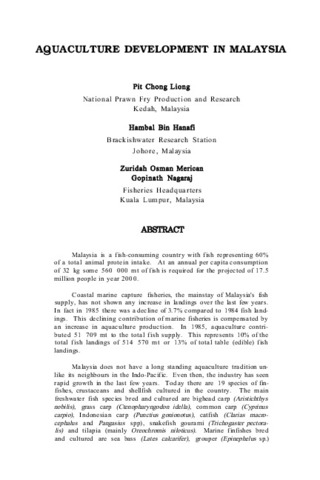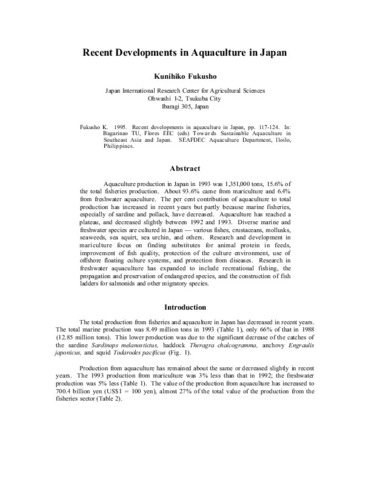The macronutrient composition of natural food organisms mass cultured as larval feed for fish and prawns
| dc.contributor.author | Millamena, Oseni M. | |
| dc.contributor.author | Peñaflorida, Veronica D. | |
| dc.contributor.author | Subosa, Precilla F. | |
| dc.date.accessioned | 2013-01-21T05:58:38Z | |
| dc.date.available | 2013-01-21T05:58:38Z | |
| dc.date.issued | 1990 | |
| dc.identifier.citation | Millamena, O. M., Peñaflorida, V. D., & Subosa, P. F. (1990). The macronutrient composition of natural food organisms mass cultured as larval feed for fish and prawns. Israeli Journal of Aquaculture, 42(3), 77–83. | en |
| dc.identifier.issn | 0792-156X | |
| dc.identifier.uri | http://hdl.handle.net/10862/1318 | |
| dc.description.abstract | The macronutrient composition of natural food organisms that are mass cultured as feed for the larval stages of fish and prawns in the SEAFDEC Aquaculture Department was determined by chemical analysis. The food organisms included five species of marine phytoplanktons (algae): Chaetoceros calcitrans, Skeletonema costatum, Tetraselmis chui, Chlorella vulgaris and Isochrysis galbana, and two zooplanktons: Artemia sp. nauplii (San Francisco Bay strain) and Brachionus plicatilis. The algal species were grown in batches on Guillard and Ryther media and harvested during the exponential phase of growth using a procedure which preserved cellular integrity and prevented cell lysis. The zooplankton were cultured using standard techniques adopted at the SEAFDEC Larval Food Laboratory. Each species was analyzed for proximate composition (protein, fat, fiber and ash) and for mineral content (calcium and phosphorous). Nitrogen-free extract (NFE) was determined by difference. For the five algal species, the protein, fat and NFE contents varied from 22% to 48%, 2% to 16% and 14% to 24%, respectively. The zooplanktons had higher protein and fat contents than any of the phytoplankton species except I. galbana which had the highest fat content. On the other hand, the phytoplanktons, particularly the diatoms which have a siliceous cell wall, contained significantly higher quantities of inorganic matter (ash). C. vulgaris had the highest fiber content which may be attributed to its cellulosic cell wall. | en |
| dc.language.iso | en | en |
| dc.publisher | Society of Israeli Aquaculture and Marine Biotechnology | en |
| dc.title | The macronutrient composition of natural food organisms mass cultured as larval feed for fish and prawns | en |
| dc.type | Article | en |
| dc.citation.volume | 42 | |
| dc.citation.issue | 3 | |
| dc.citation.spage | 77 | |
| dc.citation.epage | 83 | |
| dc.citation.journalTitle | The Israeli Journal of Aquaculture-Bamidgeh | en |
| seafdecaqd.library.callnumber | VF SJ 0299 | |
| seafdecaqd.databank.controlnumber | 1990-22 | |
| dc.subject.asfa | Algae | en |
| dc.subject.asfa | algal culture | en |
| dc.subject.asfa | aquaculture | en |
| dc.subject.asfa | biochemical composition | en |
| dc.subject.asfa | diet | en |
| dc.subject.asfa | fish culture | en |
| dc.subject.asfa | fish larvae | en |
| dc.subject.asfa | cultured organisms | en |
| dc.subject.asfa | mass culture | en |
| dc.subject.asfa | nauplii | en |
| dc.subject.asfa | nutritive value | en |
| dc.subject.asfa | phytoplankton | en |
| dc.subject.asfa | phytoplankton culture | en |
| dc.subject.asfa | prawn culture | en |
| dc.subject.asfa | zooplankton culture | en |
Files in this item
| Files | ขนาด | รูป | View |
|---|---|---|---|
|
There are no files associated with this item. |
|||
รายการนี้ปรากฏใน (s)
-
Journal Articles [1258]
These papers were contributed by Department staff to various national and international journals.



